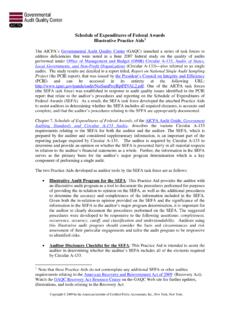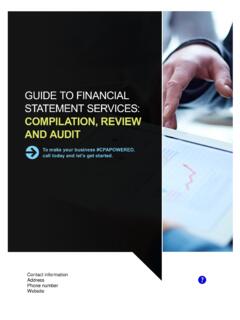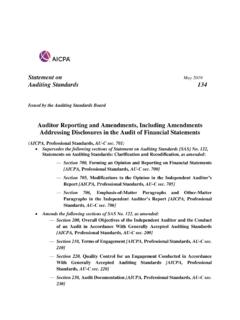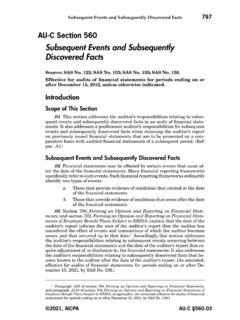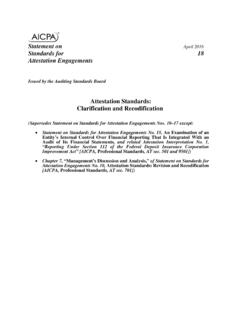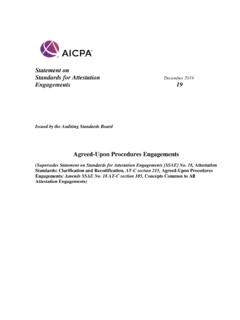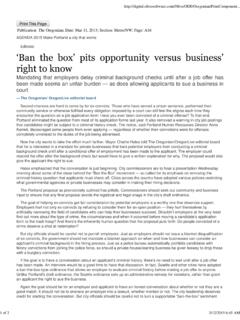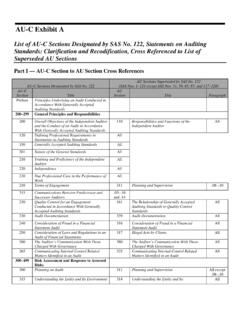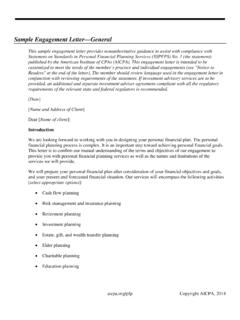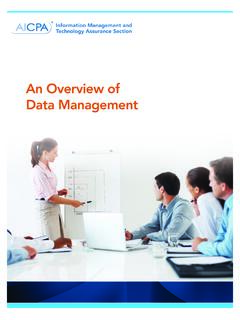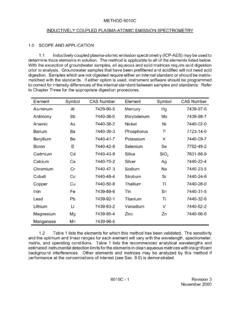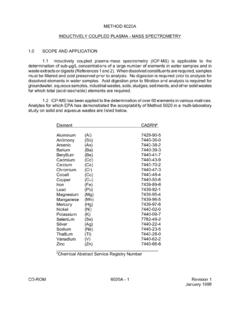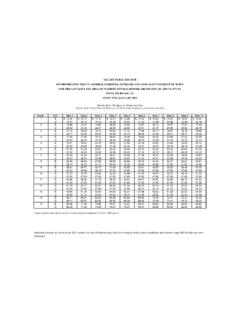Transcription of Attest Engagements - American Institute of Certified ...
1 AttestEngagements1389AT Section 101 Attest EngagementsSource: SSAE No. 10; SSAE No. 11; SSAE No. 12; SSAE No. section 9101 for interpretations of this when the subject matter or assertion is as of or for a period ending onor after June 1, 2001, unless otherwise section applies to Engagements , except for those services dis-cussed in paragraph .04, in which a Certified public accountant in publicpractice1(hereinafter referred to as apractitioner) is engaged to issue or doesissue an examination, a review, or an agreed-upon procedures report on subjectmatter, or an assertion about the subject matter (hereafter referred to asthe as-sertion), that is the responsibility of another [Revised, January 2015, toreflect conforming changes necessary due to the issuance of the revised AICPACode of Professional Conduct, effective December 15, 2014.]
2 ].02 This section establishes a framework for attest3engagements per-formed by practitioners and for the ongoing development of related certain subject matter, specific attestation standards have been developedto provide additional requirements for engagement performance and a practitioner undertakes an Attest engagement for the bene-fit of a government body or agency and agrees to follow specified governmentstandards, guides, procedures, statutes, rules, and regulations, the practitioneris obliged to follow those governmental requirements as well as the applicableattestation services provided by practitioners that are not covered bythis SSAE include the performed in accordance with Statements on Auditing Stan-dards (SASs) performed in accordance with Statements on Standards forAccounting and Review Services (SSARSs) performed in accordance with the Statement on Standardsfor Consulting Services (SSCS), such as Engagements in which thepractitioner's role is solely to assist the client (for example, acting asthe company accountant in preparing information other than financial1 For a definition of the termpublic practice, see ET section ,Definitions.)
3 [Footnote revised,January 2015, to reflect conforming changes necessary due to the issuance of the revised AICPA Codeof Professional Conduct, effective December 15, 2014.]2 See paragraph .02 of section 301,Financial Forecasts and Projections, for additional guidanceon applicability when engaged to provide an Attest service on a financial forecast or termattestand its variants, such asattestingandattestation,are used in a number ofstate accountancy laws, and in regulations issued by state boards of accountancy under such laws,for different purposes and with different meanings from those intended by this section. Consequently,the definition ofattest engagementsset out in paragraph .01, and the attendant meaning ofattestandattestationas used throughout the section, should not be understood as defining these terms andsimilar terms, as they are used in any law or regulation, nor as embodying a common understandingof the terms which may also be reflected in such laws or regulations.
4 2016, AICPAAT ), or Engagements in which a practitioner is engaged to tes-tify as an expert witness in accounting, auditing, taxation, or othermatters, given certain stipulated factsd. Engagements in which the practitioner is engaged to advocate aclient's position for example, tax matters being reviewed by the In-ternal Revenue Engagements in which a practitioner is engaged to prepare taxreturns or provide tax Attest engagement may be part of a larger engagement , for ex-ample, a feasibility study or business acquisition study may also include anexamination of prospective financial information. In such circumstances, thesestandards apply only to the Attest portion of the professional service resulting in the expression of assurance mustbe performed under AICPA professional standards that provide for the expres-sion of such assurance.
5 Reports issued by a practitioner in connection with otherprofessional standards should be written to be clearly distinguishable from andnot to be confused with Attest reports. For example, a practitioner performingan engagement which is intended solely to assist an organization in improvingits controls over the privacy of client data should not issue a report as a resultof that engagement expressing assurance as to the effectiveness of such con-trols. Additionally, a report that merely excludes the words, " ..was conductedin accordance with attestation standards established by the American Instituteof Certified Public " but is otherwise similar to an examination,a review or an agreed-upon procedures Attest report may be inferred to be anattest and Underlying ConceptsSubject subject matter of an Attest engagement may take many forms,including the or prospective performance or condition (for example, histor-ical or prospective financial information, performance measurements,and backlog data) characteristics (for example, narrative descriptions, squarefootage of facilities) events (for example, the price of a market basket of goodson a certain date) (for example, break-even analyses)
6 And processes (for example, internal control) (for example, corporate governance, compliance with lawsand regulations, and human resource practices)The subject matter may be as of a point in time or for a period of assertion is any declaration or set of declarations about whetherthe subject matter is based on or in conformity with the criteria practitioner may report on a written assertion or may report di-rectly on the subject matter. In either case, the practitioner should ordinarilyobtain a written assertion in an examination or a review engagement . A writ-ten assertion may be presented to a practitioner in a number of ways, suchAT 2016, AICPAA ttestEngagements1391as in a narrative description, within a schedule, or as part of a representationletter appropriately identifying what is being presented and the point in timeor period of time a written assertion has not been obtained, a practitioner maystill report on the subject matter; however, the form of the report will vary de-pending on the circumstances and its use should be this section,see paragraphs.
7 58 and .60 on gathering sufficient evidence and .75 and .78 .80 for reporting partyis defined as the person or persons, either asindividuals or representatives of the entity, responsible for the subject the nature of the subject matter is such that no such party exists, a party whohas a reasonable basis for making a written assertion about the subject mattermay provide such an assertion (hereinafter referred to as theresponsible party)..12 The practitioner may be engaged to gather information to enable theresponsible party to evaluate the subject matter in connection with providing awritten assertion. Regardless of the procedures performed by the practitioner,the responsible party must accept responsibility for its assertion and the subjectmatter and must not base its assertion solely on the practitioner's the practitioner's role in an Attest engagement is that of anattester, the practitioner should not take on the role of the responsible partyin an Attest engagement .
8 Therefore, the need to clearly identify a responsibleparty is a prerequisite for an Attest engagement . A practitioner may accept anengagement to perform an examination, a review or an agreed-upon proceduresengagement on subject matter or an assertion related thereto provided that oneof the following conditions is party wishing to engage the practitioner is responsible for the sub-ject matter, or has a reasonable basis for providing a written assertionabout the subject matter if the nature of the subject matter is suchthat a responsible party does not otherwise party wishing to engage the practitioner is not responsible forthe subject matter but is able to provide the practitioner, or havea third party who is responsible for the subject matter provide thepractitioner.
9 With evidence of the third party's responsibility for thesubject practitioner should obtain written acknowledgment or other evi-dence of the responsible party's responsibility for the subject matter, or the writ-ten assertion, as it relates to the objective of the engagement . The responsibleparty can acknowledge that responsibility in a number of ways, for example, inan engagement letter, a representation letter, or the presentation of the subjectmatter, including the notes thereto, or the written assertion. If the practitioneris not able to directly obtain written acknowledgment, the practitioner shouldobtain other evidence of the responsible party's responsibility for the subjectmatter (for example, by reference to legislation, a regulation, or a contract).
10 4 When the practitioner is unable to perform the inquiry and analytical or other procedures thathe or she considers necessary to achieve the limited assurance contemplated by a review, or whenthe client is the responsible party and does not provide the practitioner with a written assertion, thereview will be incomplete. A review that is incomplete is not an adequate basis for issuing a reviewreport and, accordingly, the practitioner should withdraw from the paragraph .112 regarding the practitioner's assistance in developing subject matter or cri-teria. 2016, AICPAAT to Agreed-Upon Procedures agreed-upon procedures Attest engagement is one in which a prac-titioner is engaged to issue a report of findings based on specific proceduresperformed on subject matter.
